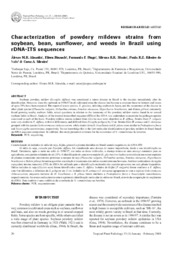Characterization of EST libraries from soybean plants involved in resistant and susceptible interactions with the asian soybean rust pathogen.
Characterization of EST libraries from soybean plants involved in resistant and susceptible interactions with the asian soybean rust pathogen.
Autoria: SILVA, D. C. G.; MORTEL, M. van de; LEMOS, N. G.; STOLF, R.; ALMEIDA, A. M. R.; NEPOMUCENO, A. L.; YAMANAKA, N.; BAUM, T. J.; WHITHAM, S. A.; ABDELNOOR, R.
Resumo: Asian rust, caused by Phakopsora pachyrhizi, is one of the most important soybean diseases. Despite of its importance, little is known about the molecular mechanism of interaction between the soybean plant and this pathogen. The aim of this study was to analyze four suppression subtractive hybridization (SSH) cDNA libraries of soybean under rust infection, in order to identify transcripts involved in soybean rust resistance. Leaf samples of the resistant soybean line PI230970 and the susceptible cultivar Embrapa 48 were collected at 24 and 192 hours after inoculation. Using SSH we generated four libraries: P24 and P192 (from PI230970), E24 and E192 (from Embrapa 48). A total of 4,704 clones were obtained from these four libraries, consisting of 1,456 clones from P24 library, 960 clones from P192 library, 2,000 clones from E24 library, and 672 clones from E192 library. The libraries were sequenced and compared to GenBank non-redundant (nr/nt) database using the tBLASTX algorithm. More than 90% of the sequences had good sequence quality (Phred>20) and 1,281 (27.2%) clones were unique sequences, resulting in an average redundancy of 71.4%. The automatic functional categorization by Gene Ontology over the non-redundant libraries revealed the biological processes response to other organisms, glycolysis, defense response, and systemic acquired resistance as the most representative. These results will contribute to the comprehension of the resistance mechanisms of soybean plants to this pathogen, and can assist the development of more efficient methods to control this disease.
Ano de publicação: 2008
Tipo de publicação: Resumo em anais e proceedings
Unidade: Embrapa Soja
Observações
1 - Por padrão são exibidas publicações dos últimos 20 anos. Para encontrar publicações mais antigas, configure o filtro ano de publicação, colocando o ano a partir do qual você deseja encontrar publicações. O filtro está na coluna da esquerda na busca acima.
2 - Para ler algumas publicações da Embrapa (apenas as que estão em formato ePub), é necessário ter, no celular ou computador, um desses softwares gratuitos. Sistemas Android: Google Play Livros; IOS: iBooks; Windows e Linux: software Calibre.
Acesse outras publicações
Acesse a Base de Dados da Pesquisa Agropecuária (BDPA) para consultar o acervo completo das bibliotecas da Embrapa.

